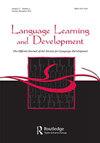The Influence of Accent Distance on Perceptual Adaptation in Toddlers and Adults
IF 1.4
2区 文学
0 LANGUAGE & LINGUISTICS
引用次数: 1
Abstract
ABSTRACT Foreign accents can vary considerably in the degree to which they deviate from the listener’s native accent, but little is known about how the relationship between a speaker’s accent and a listener’s native language phonology mediates adaptation. Using an artificial accent methodology, we addressed this issue by constructing a set of three artificial accents (Near, Far, and Farther), varying in the number and magnitude of pronunciation deviations from standard Canadian English. These accents were presented to toddlers and adults in an eye-tracking task. Regardless of accent type, adults readily adapted to the exposed pronunciation change. Adults exposed to the Farther accent were also more willing to accept novel pronunciation changes. Young toddlers exposed to Far or Farther accents showed no evidence of acquiring the exposed pronunciation change and demonstrated worse word recognition for standard Canadian-accented words. These findings suggest that when a speaker’s accent deviates substantially from a young toddler’s native accent, this may lead to a significant decrement in their ability to recognize not only an unfamiliar accent but also native-accented speech. Overall, these findings provide a well-controlled test of competing models of accent adaptation and generate multiple hypotheses to be examined in the future using more ecologically valid stimuli.口音距离对幼儿和成人知觉适应的影响
外国口音在很大程度上偏离听者的母语口音,但很少有人知道说话者的口音和听者的母语语音之间的关系是如何调节适应的。使用人工口音方法,我们通过构建一组三种人工口音(Near、Far和Farther)来解决这个问题,这些口音与标准加拿大英语的发音偏差在数量和程度上都有所不同。在一项眼球追踪任务中,这些口音被呈现给幼儿和成年人。无论何种口音类型,成年人都很容易适应暴露的发音变化。接触更远口音的成年人也更愿意接受新的发音变化。暴露在Far或Farther口音下的幼儿没有表现出获得暴露的发音变化的证据,并且对标准加拿大口音单词的识别能力更差。这些发现表明,当说话者的口音与幼儿的母语口音明显偏离时,这可能会导致他们识别不熟悉的口音和母语口音的能力显著下降。总的来说,这些发现为口音适应的竞争模型提供了一个良好的控制测试,并产生了多个假设,供未来使用更生态有效的刺激进行检验。
本文章由计算机程序翻译,如有差异,请以英文原文为准。
求助全文
约1分钟内获得全文
求助全文

 求助内容:
求助内容: 应助结果提醒方式:
应助结果提醒方式:


